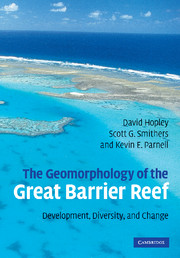Book contents
- Frontmatter
- Contents
- Preface
- Acknowledgements
- 1 Geomorphology and the Great Barrier Reef
- 2 Foundations of the Great Barrier Reef
- 3 Sea level: a primary control of long-term reef growth and geomorphological development
- 4 Oceanography, hydrodynamics, climate, and water quality as influences on reef geomorphological processes
- 5 Spatial analysis of the morphology of the reefs and islands of the Great Barrier Reef
- 6 The non-reefal areas of the continental shelf
- 7 Fringing and nearshore coral reefs
- 8 The mid-shelf reefs of the Great Barrier Reef
- 9 The coral reefs of the outer shelf of the Great Barrier Reef
- 10 Islands of the Great Barrier Reef
- 11 The accumulation of the Holocene veneer to the Great Barrier Reef
- 12 The Holocene evolution of the Great Barrier Reef province
- 13 Geomorphology's contribution to the understanding and resolution of environmental problems of the Great Barrier Reef
- References
- Geographic index
- Subject index
7 - Fringing and nearshore coral reefs
Published online by Cambridge University Press: 22 August 2009
- Frontmatter
- Contents
- Preface
- Acknowledgements
- 1 Geomorphology and the Great Barrier Reef
- 2 Foundations of the Great Barrier Reef
- 3 Sea level: a primary control of long-term reef growth and geomorphological development
- 4 Oceanography, hydrodynamics, climate, and water quality as influences on reef geomorphological processes
- 5 Spatial analysis of the morphology of the reefs and islands of the Great Barrier Reef
- 6 The non-reefal areas of the continental shelf
- 7 Fringing and nearshore coral reefs
- 8 The mid-shelf reefs of the Great Barrier Reef
- 9 The coral reefs of the outer shelf of the Great Barrier Reef
- 10 Islands of the Great Barrier Reef
- 11 The accumulation of the Holocene veneer to the Great Barrier Reef
- 12 The Holocene evolution of the Great Barrier Reef province
- 13 Geomorphology's contribution to the understanding and resolution of environmental problems of the Great Barrier Reef
- References
- Geographic index
- Subject index
Summary
Introduction
Fringing reefs and nearshore reefs occur close to mainland or high island shores. Fringing reefs are often shore-attached, with reefal sediments extending from the fore reef to shoreline, although back reef areas can be shallowly submerged to form flooded depressions up to several hundred meters wide. However, along most of the inner Great Barrier Reef (GBR) where the majority of fringing reefs occur, relative sea level has fallen by ∼1.5 m since the mid-Holocene highstand (Section 3.4.3), and it is more typical for back reef areas to be higher than the reef crest (discussed further in Sections 7.4 and 7.5). Nearshore reefs are very close but not directly attached to mainland or high island shores, and are separated from these shorelines by back reef areas dominated by non-reefal sediments that are shallower than 10 m (Larcombe et al., 2001). Following Darwin's (1842) classification, fringing reefs are interpreted as the first stage in a long-term evolutionary sequence, in which reef growth is initiated over a substrate on the shoreline, but later becomes separated from the shore as the underlying substrate gradually subsides and a leeward lagoon develops. Fringing reefs are thus often considered as characteristic of stable or uplifting coasts, where the geomorphological transition from fringing to barrier reef is suppressed by a lack of subsidence. However, as discussed in this chapter, the influence of slow geological subsidence on modern fringing reef growth on the Great Barrier Reef and elsewhere is often relatively small compared to that of more rapid changes in relative sea level through the Holocene.
- Type
- Chapter
- Information
- The Geomorphology of the Great Barrier ReefDevelopment, Diversity and Change, pp. 191 - 232Publisher: Cambridge University PressPrint publication year: 2007



